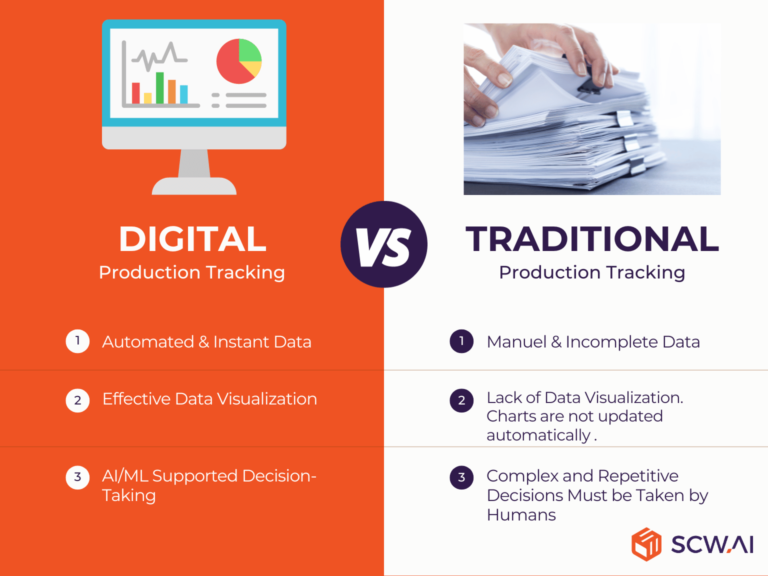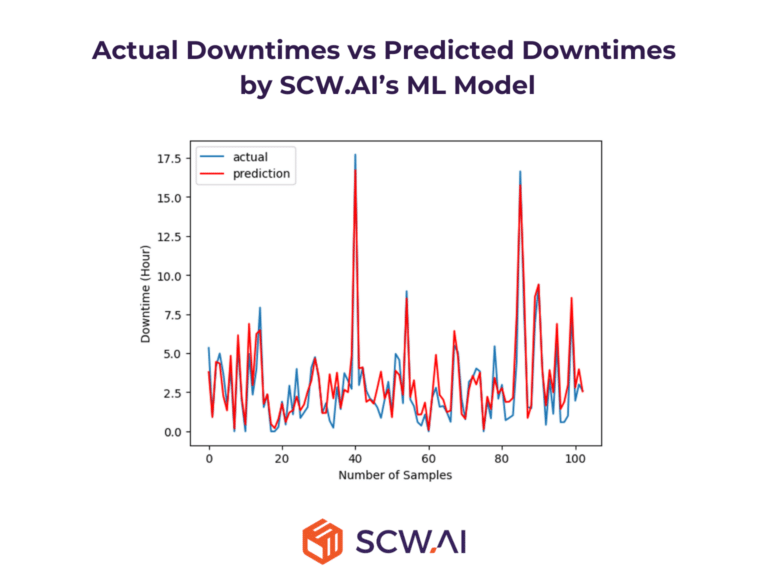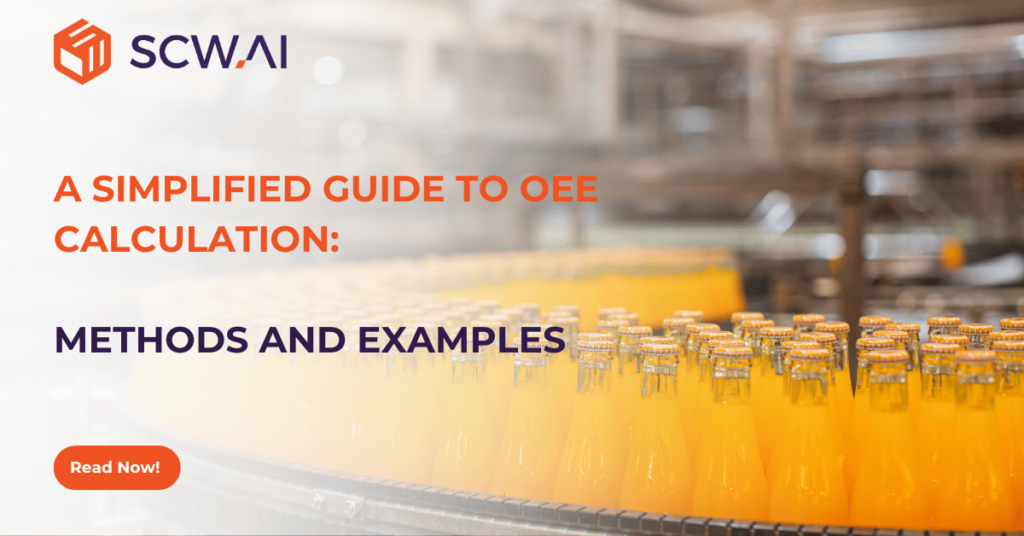In a collaborative research effort between the World Economic Forum and McKinsey, only 103 out of ≅10,000 assessed factories have been identified as successfully undergoing digital transformation through Industry 4.0. This highlights a substantial gap in the digitalization of the manufacturing industry. Conversely, Industry 4.0 technologies significantly enhance end-to-end production tracking and, as suggested by Bain and Company, have the potential to reduce costs by up to 30%.
This article seeks to close the digitalization gap in the manufacturing sector by highlighting business opportunities that executives may be missing via visibility of shop floors. With this objective in mind, in this article, we demonstrate how digital tools:
- Have transformed real-time production tracking.
- Can be effectively utilized by the factories.
- May improve five different areas of the production.
How to Track Production in Manufacturing via Digital Tools?
Production tracking through digital tools involves gathering shop floor data related to processes, work orders, machines, employees, and more. This data is then visualized in user-friendly dashboards. Subsequently, data not only provides support but is often harnessed to automate decision-making processes, leveraging artificial intelligence (AI) and machine learning (ML) algorithms
Following technologies can be used for digitizing production tracking:
- Industrial IoT: Intelligent sensors can automate the collection of data related to the environment, machines, and the location of employees. IoT devices provide real-time data on the factory’s temperature, humidity, and the operational metrics of production, including machine performance, heat generation, and electric current. Additionally, they can track employee check-ins at specific production lines, enhancing shop floor visibility.
- Cloud Applications: Technology vendors offer easily scalable SaaS solutions to manufacturers, delivering dashboards, and, in some cases, predictive capabilities to aid decision-makers. The use cases of SaaS solutions can range from maximizing Overall Equipment Effectiveness (OEE) to optimizing work orders schedules, tracking carbon footprints, calculating On-Time-In-Full (OTIF) performance and more.
- AI/ML: Advanced analytics, computer vision, deep learning, and generative AI have significant potential to revolutionize the factories of the future by determining optimal maintenance strategies, detecting anomalies in factories and supervising production lines.
- Digital Twins: This technology optimizes planning by running simulations through the replication of factory assets and feeding it with historical data. According to Gartner’s 2023 Hype Cycle for Artificial Intelligence, ongoing investments in digital twins are anticipated, with widespread adoption expected by many companies over the next decade.
- Blockchain: While only 4% of manufacturing executives currently prioritize blockchain, according to a Deloitte survey, its proliferation in the near future is likely. Blockchain facilitates secure and accountable data exchange throughout the supply chain, making it a valuable prospect for widespread adoption.

A Comparison of Production Tracking: Before and Now
Manufacturers find that using digital factory technologies for data collecting and processing is far more efficient than using outdated methods like Excel sheets. Sheets lack instant data availability and intuitive data representation capabilities that are crucial for production tracking and factory monitoring, while methods like preparing paper documents can take weeks without the added benefit of AI recommendations.

Identifying bottlenecks and proactively addressing them through digital factory transformation yields a return on investment, as outlined by Bain and Company. Manufacturers stand to gain the following benefits according to report:
- OEE improvement up to 35%.
- Labor productivity increase up to 25%.
- Plant output enhancement up to 40%.
- Faster production capability up to 20%.
Top 3 Features of Effective Production Tracking Systems
At SCW.AI, we assess the effectiveness of digitization efforts through a framework called 3D, which encompasses:
- Data
- Dashboard
- Decisions

Here are the details outlining the 3D framework and features of effective production tracking systems:
1. Providing High Quality Production Data
Data serves as the cornerstone of visibility and monitoring in manufacturing, showcasing alignment with goals and the results of actions. Successful digital operations rely on the collection of:
- Accurate
- Real-time
- And granular data.
In addition, data must be complete and free of overlaps and errors. Managing information in a centralized database makes it easily accessible for monitoring and analysis. To ensure the acquisition of high-quality data, managers can streamline the collection process using IoT devices or, in some cases, blockchain.
2. Presenting Data through User-Friendly Dashboards
Managers must have dashboards that are easy to navigate in order to extract insights from the data they have gathered. Dashboards make data actionable by facilitating the identification of opportunities, trends, and bottlenecks.
Well-designed dashboards employ a variety of colors to represent data effectively. They initially provide a comprehensive overview to identify bottlenecks, then offer detailed insights regarding production lines, specific equipment and labor resources, and unique work orders. These dashboards often feature widely used Key Performance Indicators (KPIs) within the manufacturing industry.
3. Facilitating Decision-Making with Insights and AI
Possessing high-quality data and gaining insights through dashboards holds value only when executives take decisive actions. Data-driven decision-making ranges from personal actions, such as exploring new ways to utilize machinery, to automated decisions facilitated by AI, such as cost-effective scheduling.
Top 5 Digital Production Tracking Use Cases for Manufacturers

1. Comprehensive Factory Monitoring
Managers can effortlessly monitor their manufacturing operations with just a few clicks thanks to digital production tracking systems that provide real-time information on:
- Global View: Many manufacturers operate in diverse geographic locations. The Global View capabilities enable managers to monitor KPIs such as the number of working, idle, and down machines, along with the current OEE for each factory. This enables swift issue identification; for instance, if a problem arises in a factory in Italy, managers can promptly identify it by examining downtime metrics and the current OEE.
- Site View: This tool is specifically designed to delve into and identify the root cause of a problem. In the aforementioned example, if the factory in Italy is identified as underproductive, utilizing Site View allows managers to scrutinize KPIs related to employees and machines on a line-by-line basis, facilitating the identification of the root cause.
Explore insights into the average OEE performance of pharmaceutical manufacturers and discover strategies for improvement in our article, World Class OEE in Pharma: A Benchmarking Analysis.
2. Reduction of Changeover Time
Through the analysis of data related to the type of changeovers, their durations, and the variance between scheduled and actual changeovers, managers can effectively minimize changeover time. According to our findings, utilizing digital tools to reduce changeover time can enhance throughput by up to 5% for pharmaceutical manufacturers.
A recommended best practice to achieve this is to decrease the number of major changeovers by optimizing scheduling. This involves arranging work orders that necessitate minor changeovers consecutively, thereby streamlining the changeover process.
3. Enhancement of Equipment Lifespan
If managers have access to real-time metrics concerning mean time to failure, mean time to repair, and mean time between failures, they can anticipate machine failures before they occur. Through preventive maintenance, they can effectively enhance equipment lifespan.
Yet, an innovative maintenance strategy for manufacturers involves harnessing ML models for predictive maintenance. Leveraging historical data and specific algorithms, ML models can accurately forecast equipment malfunctions, providing timely alerts to managers for proactive intervention.
According to Deloitte, this cutting-edge strategy for maintenance can increase machine run time up to 20%.

4. Optimization of Production Scheduling
Effectiveness of production planning can be crucial for:
- Reducing manufacturing cost
- Ensuring timely delivery and reducing on-time in-full (OTIF) penalties
- Minimizing carbon footprint and more.
Today, AI-driven scheduler tools are able to optimize scheduling for factors mentioned above. By analyzing factory data, they can decide which work orders must be produced first to lessen costs or time.
5. Augmentation of Labor Productivity with Real-Time Location Systems
Real-time location systems (RTLS) empower managers to monitor labor activity and analyze the relationships between specific shifts, workers, machines, products, and productivity. The RTLS system is activated when a worker checks in at a particular production line.
Dashboards typically feature a floor plan of the factory, displaying workers with their avatars in specific locations. Thanks to its real-time tracking capabilities, RTLS also enhances labor safety.
How Can SCW.AI Digitize Production Tracking?
SCW.AI’s next-generation Digital Factory Platform offers tailored digital solutions for specific production monitoring use cases outlined above.
- Factory Monitoring: Utilize SCW.AI’s Global View and Site View Reports.
- Changeover Reduction: Leverage SCW.AI’s Changeover Analysis Report.
- Enhancement of Equipment Lifespan: Employ SCW.AI’s Maintenance Performance Report, ML models for Predictive Maintenance, and Asset Tracker.
- Optimal Scheduling: Rely on SCW.AI’s AI-Driven Scheduler.
- RTLS: Utilize SCW.AI’s Labor Tracker.
Start the future of manufacturing in your factory today by booking a demo with us!


